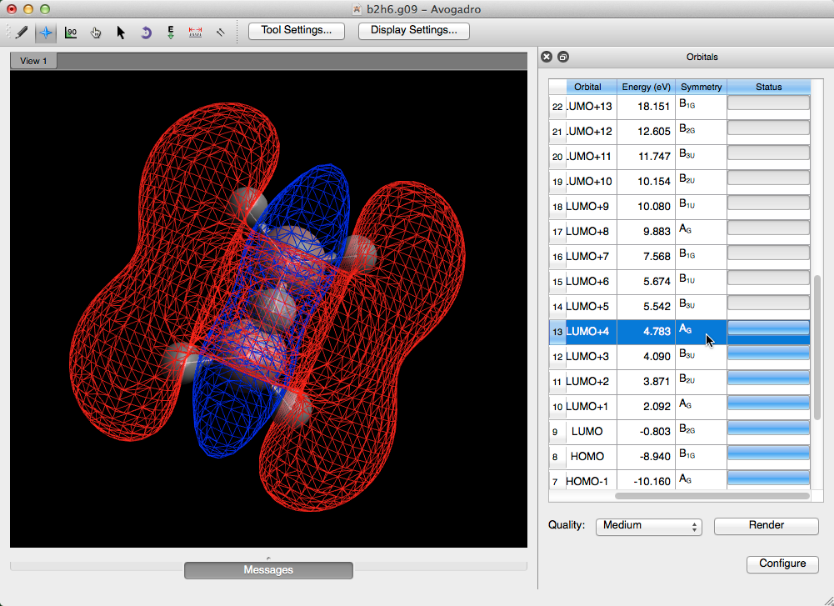Best Free Computational Chemistry Software

Avogadro
This is a molecular editor and builder which has a large capacity for plugins with other popular computational softwares including GAMESS and Orca. It’s core functions are limited on it’s own but it was designed with cross-platform compatibility in mind. As for the editing framework itself, it functions well with an intuitive drag and place system which is much better than others.
It’s manual was designed for Mac users but having used on Windows the guide is still just as easy to use.
You can import molecules from PDB, build using SMILES nomenclature and peptide and DNA structures are no problem for the program.
Optimising geometries is easy to do and viewing spectra, vibrational modes and molecular orbitals is possible in just a few clicks.
Overall this is a powerful companion for other computational software and you can download and start drawing molecules in a matter of minutes.
Download link: https://sourceforge.net/projects/avogadro/files/latest/download

Orca
This package is free for educational users for academic purposes. The package itself is easy to use but powerful at the same time. You can carry out density functional theory (DFT) calculations, many-body perturbation, coupled cluster and many other calculations. It claims to be able to treat environmental and relativistic effects into calculations.
Orca has a large focus and application to open-shell molecules, transition metal complexes and each respective spectroscopic properties.
It has great cross-platform compatibility with Avogadro (mentioned above) and as a combination offers capabilities much like many paid for software packages.
By signing up to the forum through the official website here: https://orcaforum.kofo.mpg.de/app.php/portal you can download your version for free.

GAMESS US
Similar to Orca, GAMESS is an ab initio molecular quantum chemistry program. It can compute self-consistent field, SCF wavefunction methods such as RHF, ROHF, UHF, GVB, and MCSCF. It is also capable of DFT approximations and coupled cluster approaches. Hessian energy predictions allow for vibrational frequencies with IR and Raman intensity predictions. Solvent effects, relativistic computations and nuclear wavefunctions can also be generated.
Again this package has extension compatibility with Avogadro which can be used for both input and output applications.
In summary, it is a very powerful free package for educational and academic purposes.
A download link is sent via email once approved by administrators at the link here: https://www.msg.chem.iastate.edu/gamess/download.html

NWChem
NWChem is an open source software for the computational of molecular systems using classical molecular dynamics and quantum mechanical descriptions and simulations. It allows for mixed quantum mechanics and molecular mechanics solutions.
It’s capabilities are summarised below:
Molecular Electronic Structure:
Methods for determining energies and analytic first derivatives with respect to atomic coordinates include the following:
- Hartree-Fock (RHF, UHF, high-spin ROHF)
- Gaussian orbital-based density functional theory (DFT) using many local and non-local exchange-correlation potentials (LDA, LSDA)
- second-order perturbation theory (MP2) with RHF and UHF references
- complete active space self-consistent field theory (CASSCF).
Quantum Mechanics / Molecular Mechanic Methods:
The QM/MM module in NWChem provides a comprehensive set of capabilities to study ground and excited state properties of large-molecular systems. The QM/MM module can be used with practically any quantum mechanical method available in NWChem. The following tasks are supported
- single point energy and property calculations
- excited states calculation
- optimizations and transition state search
- dynamics
- free energy calculations.
It’s input and output compatible with Avogadro for ease of use.
Download and guide here: https://nwchemgit.github.io/

CP2K Open Source Molecular Dynamics
An open source quantum chemistry software package which is free to all users under the GPL licence. it is capable of performing atomistic simulations of solid state, liquid, molecular, material, crystal and biological systems. It can carry out DFT modelling using mixed Gaussian and plane waves approaches.
The simulation capabilities are molecular dynamics, metadynamics, Monte Carlo, Ehrenfest dynamics, vibrational analysis, core level spectroscopy, energy minimization, and transition state optimization.
Ab-initio electronic structure theory methods using the QUICKSTEP module
- Density-Functional Theory (DFT) energies and forces
- Hartree-Fock (HF) energies and forces
- Moeller-Plesset 2nd order perturbation theory (MP2) energies and forces
- Random Phase Approximation (RPA) energies
- Gas phase or Periodic boundary conditions (PBC)
- Basis sets include various standard Gaussian-Type Orbitals (GTOs), Pseudopotential plane-waves (PW), and a mixed Gaussian and (augmented) plane wave approach (GPW/GAPW)
- PW DFT functionality (energy, forces, stress), including LAPW (all-electron)
- Norm-conserving, seperable Goedecker-Teter-Hutter (GTH) and non-linear core corrected (NLCC) pseudopotentials, or all-electron calculations
- Local Density Approximation (LDA) XC functionals including SVWN3, SVWN5, PW92 and PADE
- Gradient-corrected (GGA) XC functionals including BLYP, BP86, PW91, PBE and HCTH120 as well as the meta-GGA XC functional TPSS
- Hybrid XC functionals with exact Hartree-Fock Exchange (HFX) including B3LYP, PBE0 and MCY3
- Double-hybrid XC functionals including B2PLYP and B2GPPLYP
- Additional XC functionals via LibXC
- Dispersion corrections via DFT-D2 and DFT-D3 pair-potential models
- Non-local van der Waals corrections for XC functionals including B88-vdW, PBE-vdW and B97X-D
- DFT+U (Hubbard) correction
- Density-Fitting for DFT via Bloechl or Density Derived Atomic Point Charges (DDAPC) charges, for HFX via Auxiliary Density Matrix Methods (ADMM) and for MP2/RPA via Resolution-of-identity (RI)
- Sparse matrix and prescreening techniques for linear-scaling Kohn-Sham (KS) matrix computation
- Orbital Transformation (OT) or Direct Inversion of the iterative subspace (DIIS) self-consistent field (SCF) minimizer
- Local Resolution-of-Identity Projector Augmented Wave method (LRIGPW)
- Absolutely Localized Molecular Orbitals SCF (ALMO–SCF) energies for linear scaling of molecular systems
- Excited states via time-dependent density-functional perturbation theory (TDDFPT)
Ab-initio Molecular Dynamics
- Born-Oppenheimer Molecular Dynamics (BOMD)
- Ehrenfest Molecular Dynamics (EMD)
- PS extrapolation of initial wavefunction
- Time-reversible Always Stable Predictor-Corrector (ASPC) integrator
- Approximate Car-Parrinello like Langevin Born-Oppenheimer Molecular Dynamics (Second-Generation Car-Parrinello Molecular Dynamics)
Mixed quantum-classical (QM/MM) simulations
- Real-space multigrid approach for the evaluation of the Coulomb interactions between the QM and the MM part
- Linear-scaling electrostatic coupling treating of periodic boundary conditions
- Adaptive QM/MM
Download and guide here: https:www.cp2k.org


Leave a Reply